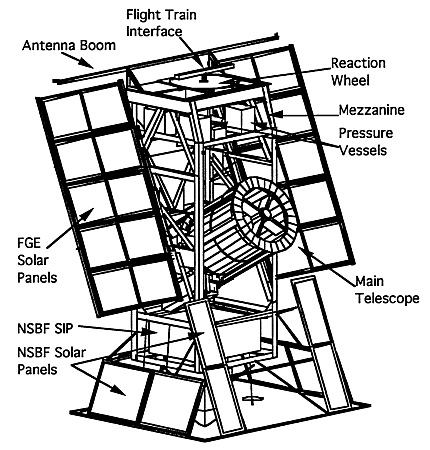Purpose of the flight and payload description
The principal objective of the Flare Genesis Experiment is to understand the origins of solar activity.
The basic design of the FGE gondola was derived from a payload (Exite instrument) developed by the Harvard/Smithsonian Center for Astrophysics (CFA). The frame is bolted together from standard aluminum angle. This approach was adopted to simplify both material procurement and construction.
The structure is strong enough to support the 4400-lb weight of the instrumentation, telescope, NSBF's Support Instrument Package (SIP), ballast and solar panels, even under a design load of 10 g, as well as being rigid enough to allow stable pointing to at least 10 arcsec.
The payload can measure the surface magnetic fields and motions with a unique balloon-borne 80-cm (aperture) Cassegrian telescope and an advanced pointing system with a secondary telescope.
By observing continuously from the Antarctic stratosphere, above 99.7% of the atmosphere, he overcomes the principal problems that have hindered magnetic field observations from the ground.
This flight was a engineering test wich included the thermal performance, telemetry, gondola performance, reliability of the filter, and ability to command the telescope.
Some problems were encountered in handing off from the coarse pointing system to the 10" LCD system. Probably these problems were created by a wind gradient between the balloon and the payload that existed at the 80,000 ft. altitude the mission was flown at.
Since the telescope was pointed south and the flight was drifting east, a net torque results on the solar panels. At 125,000 ft. where the Antarctic mission will be flown, this torque is reduced by a factor of about eight, so no problems are expected.
(excerpts from a report from Steve Keil in NOAO Newsletter No. 38, 1 June 1994)
Details of the balloon flight
Balloon launched on: 1/23/1994 at 15:17 utc
Launch site: Scientific Flight Balloon Facility, Fort Sumner, (NM), US
Balloon launched by: National Scientific Balloon Facility (NSBF)
Balloon manufacturer/size/composition: Zero Pressure Balloon N13E-8/8/8T-2.60
Balloon serial number: R2.60-2-101
Flight identification number: 376N
End of flight (L for landing time, W for last contact, otherwise termination time): 1/24/1994 at
Balloon flight duration (F: time at float only, otherwise total flight time in d:days / h:hours or m:minutes - ): 11 h
Landing site: 3 miles SE of Paducah, Texas, US
The balloon was launched at 15:17 utc on January 23, 1994 from the NASA balloon base in Fort Sumner, New Mexico. After a nominal ascent the balloon reached float altitude of 80.000 ft. The flight was terminated after a total flight time of eleven hours. The payload landed safely 3 miles SE of Paducah, Texas.
External references
- Balloon-Borne Polarimetry - The Flare Genesis Experiment Solar Physics, Volume 164, Issue 1-2, pp. 403
- Conference of Andreas Andreou - Johns Hopkins University (11/18/21) about Flare Genesis Project (starting on minute 9:20) Institute for Neural Computation youtube channel
- Details on STARLAB, the former space mission cancelled that transferred its main telescope to be used in the Flare Genesis program
- NASA Balloon Flights (1989-1998) in NASA Historical Data Book, Vol. VII: NASA Launch Systems, Space Transportation, Human Spaceflight, and Space Science, 1989-1998
- Sitio web del experimento Flare Genesis Flare Genesis Experiment website
- The Flare Genesis Experiment: studying the Sun from the stratosphere Johns Hopkins APL Technical Digest, Volume 14, Number 4 (1993)
- The Flare Genesis project Adv. Space Res. Vol. 14, No. 2, pp. (2)89, 1994
620If you consider this website interesting or useful, you can help me to keep it up and running with a small donation to cover the operational costs. Just the equivalent of the price of a cup of coffee helps a lot.


